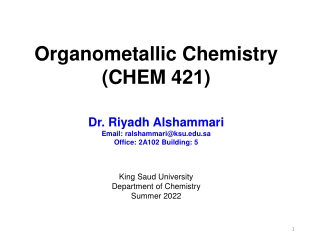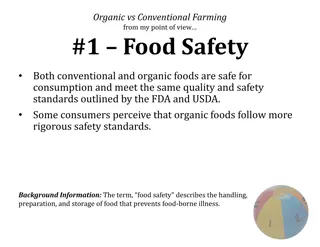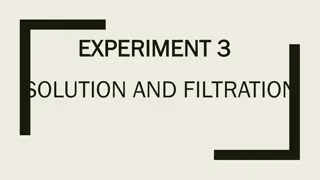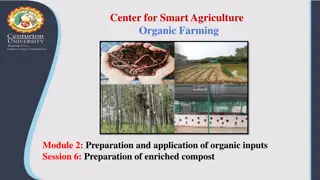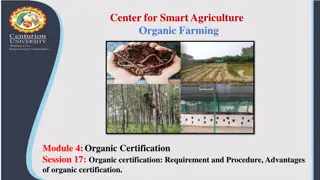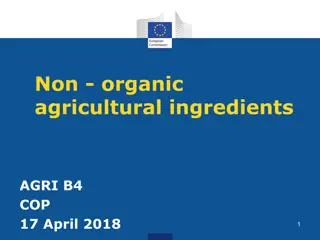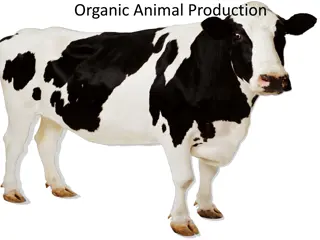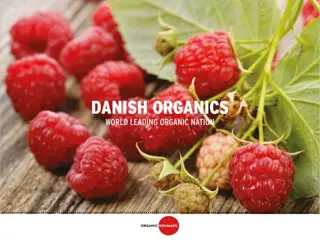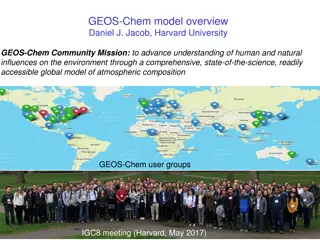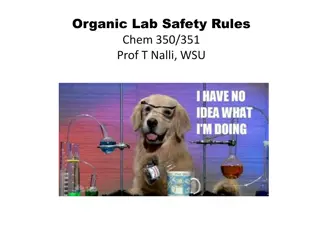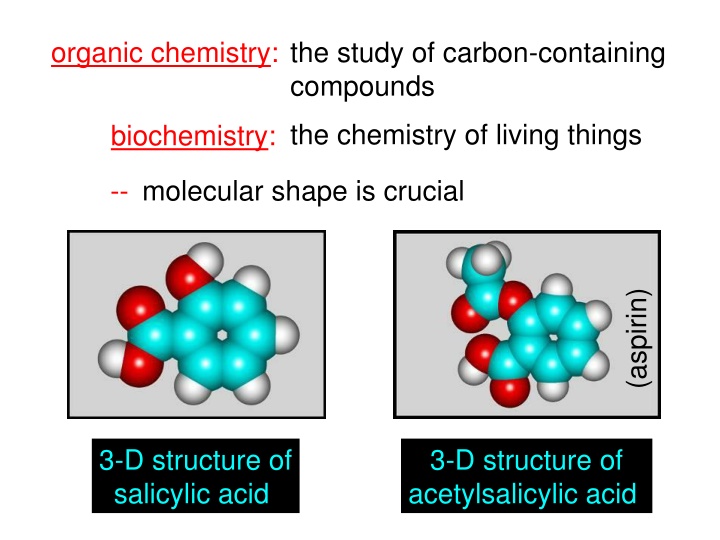
Organic Chemistry: Carbon Compounds and Molecular Structures
Explore the fundamentals of organic chemistry, focusing on carbon-containing compounds and the crucial role of molecular shape. Learn about the unique properties of carbon, hydrocarbons, alkenes, alkynes, and aromatic hydrocarbons. Review the basics of organic chemistry, including alkanes, alkenes, alkynes, and structural isomers. Understand the differences between straight-chain, branched-chain, and substituted compounds in organic chemistry.
Download Presentation

Please find below an Image/Link to download the presentation.
The content on the website is provided AS IS for your information and personal use only. It may not be sold, licensed, or shared on other websites without obtaining consent from the author. If you encounter any issues during the download, it is possible that the publisher has removed the file from their server.
You are allowed to download the files provided on this website for personal or commercial use, subject to the condition that they are used lawfully. All files are the property of their respective owners.
The content on the website is provided AS IS for your information and personal use only. It may not be sold, licensed, or shared on other websites without obtaining consent from the author.
E N D
Presentation Transcript
organic chemistry: the study of carbon-containing compounds biochemistry: the chemistry of living things -- molecular shape is crucial (aspirin) 3-D structure of salicylic acid 3-D structure of acetylsalicylic acid
Carbon is unique among the elements because: -- it can have up to four bonds per C atom single, double, or triple bonds C C C=C C=C -- it can form REALLY long chains of C atoms -- its bonds are strong STOP
hydrocarbons: compounds containing only __ and __ H C single alkanes: hydrocarbons having only ______ bonds -- ALKANES = FUEL -- very stable; no rxn w/acids, bases, strong oxidizers -- anes are saturated H H H C C C H H H H H H H H H H C C C C H H H H H H C H structural isomers: same molecular formula, different bonding arrangements
alkenes: hydrocarbons having at least one ____ bond C=C H H C=C H H C CH2CHCH3 H H C=C alkynes: hydrocarbons having at least one ____ bond H H H H H C C=C C C C H H H H H The simplest alkyne, ethyne (i.e., acetylene) C2H2 is the fuel in oxyacetylene torches. CH3CC(CH2)2CH3
aromatic hydrocarbons: benzene and compounds w/a benzene-related structure 6 C atoms in a planar ring w/ tweener bonds (C6H6) -- enes, ynes, and aromatics are __________ unsaturated August Kekule (1829 1896), who claimed that a dream gave him insight into the structure of benzene. STOP
REVIEW: Organic Chemistry Basics 1. Alkanes have only single bonds. Because they cannot take on any additional atoms, alkanes are saturated hydrocarbons. 2. Alkenes have at least one carbon-carbon double bond; alkynes have at least one carbon-carbon triple bond. Aromatic compounds are based on the benzene molecule, C6H6. Because alkenes, alkynes, and aromatic compounds can take on additional atoms, they are unsaturated. 3. Structural isomers have the same molecular molecular formula, but have atoms w/different w/different bonding arrangements.
C5H12 Straight-chain compounds have a single carbon backbone. CH3(CH2)3CH3 CH3CH2CH2CH2CH3 Branched-chain compounds have a main carbon backbone AND one or more branches C8H18 Substituted compounds have one or more H atoms removed, with other atoms in their place(s) (often halogens) C5H11Br Br
Branches and H-replacing atoms/groups are collectively called substituents. H Cl H Cl H Cl C C C C C C H H H Polyvinylchloride (PVC) is a material made of long-chain carbons that have many chloride substituents. H H H
Functional group: a characteristic pattern that makes up a portion of a larger m cule -- specific atoms, specific bonding arrangements -- importance: fgs largely determine the behavior of their m cules -- several examples of fgs: COOH O O = O = O OH C C OH OH ketones carboxylic acids alcohols
C6H11Br Many organic compounds are combinations of several categories. sub. Br C10H21Cl O C6H12O2 br. + sub. OH fg Cl C9H17OBr OH Br C6H13OCl O Cl fg + sub. fg + sub. + br. STOP
Organic Nomenclature Memorize the prefixes that tell the # of C atoms in a chain. pent meth eth prop but pent hex hept oct non dec 1 = 2 = 3 = 4 = 5 = 6 = 7 = 8 = 9 = 10 = non dec There are rules, but generally we will want to find the longest chain of carbons. hept
Naming Straight-Chain Alkanes 1. Find the longest continuous chain of C atoms. Choose the appropriate prefix. 2. The name ends with ane. Provide the counterpart to the given. propane (C3H8) (C7H16) heptane
Alkanes: modification for substituent hydrocarbon (HC) groups (i.e., branches) 1. Number the longest chain carbons. Start with the end nearest a branch. 2. Name and give the #ed location of each substituent. -- HC substituent groups use the prefixes based on the # of Cs, but end in yl. 3. List substituents in alphabetical order.
Provide each counterpart. 1 3 5 2 4 6 4-ethyl-2-methylhexane (C9H20) 1 2 5-ethyl-3-methyl octane 3 7 5 4 8 6 (C11H24)
SUMMARY: Alkanes, 1 Memorize these prefixes: 1 = 2 = 3 = 4 = 5 = 6 = 7 = 8 = 9 = 10 = dec To name branched alkanes: 1. Number the longest chain carbons. Start with the end nearest a branch. 2. Name and give the #ed location of each substituent. -- HC substituent groups use the prefixes based on the # of Cs, but end in yl. 3. List substituents alphabetically. meth eth prop but pent hex hept oct non
Alkanes: modification for non-HC substituents 1. The longest chain MUST contain the substituent. -- example substituents: I iodo NO2 nitro NH2 amino F fluoro Br bromo 2. Number the chain carbons, starting with the end nearest a substituent. -- A non-HC substituent takes precedence over an HC branch. 3. Name and give the #ed location of each substituent. -- If necessary, choose #s so that their sum is as low as possible.
Provide each counterpart. Br 3-bromo-2-chlorohexane Cl 2-ethyl -1,1-diiodo heptane I I 2-methyl-1-nitrobutane NO2 NH2 NO2 2-amino- 6-nitro-3-propyl heptane
Alkanes: modification for cycloalkanes -- Use the cyclo- prefix before the -ane part. Provide each counterpart. ethyl cyclohexane (C8H16) 1-bromo-1-chloro-2-methylcyclopentane (C6H10BrCl) Br Cl
SUMMARY: Alkanes, 2 In this lesson, we went through how to name alkanes that contain non-hydrocarbon substituents. The biggest ideas are: 1. The longest chain MUST contain the substituent. 2. You number the chain carbons starting with the end nearest a substituent. -- A non-hydrocarbon substituent takes precedence over a hydrocarbon branch.
Naming Alkenes and Alkynes 1. The C-chain MUST include the multiple bond. Use the ending ene or yne, as appropriate. 2. Number so that you get to the multiple bond ASAP. -- The multiple bond takes precedence over branching or substituents. 3. Use di- or tri- right before ene or yne if you have two or three multiple bonds. Polyunsaturated fats and oils contain double and/or triple bonds.
Provide each counterpart. 1-butyne (C4H6) 2-butyne (C4H6) 7-methyl-2,4- nonadiene (C10H18)
7-fluoro-6-methyl-3-octyne F (C9H15F) Cl Cl Cl 3,3,4- trichloro cyclohexene (C6H7Cl3)
4. For geometric isomers (different spatial arrangements of atoms), use cis- (same) or trans- (opposite). Geometric isomerism is possible only with alkenes. Cl CH2CH3 C=C CH3CH2 Cl 3,4-dichloro-trans- 3- hexene Cl Cl C=C CH3CH2 CH2CH3 3,4-dichloro-cis- 3- hexene STOP
Benzene, Phenol, and Toluene These are the Big Three aromatic compounds. ( FEE nahl or fn AHL ) OH CH3 (C6H6) (C6H5OH) (C6H5CH3) benzene phenol toluene For phenols and toluenes, the C to which the OH or CH3 is attached is carbon #1.
Provide each counterpart. (C6H5Br) bromobenzene Br ethylbenzene (C8H10) 2-propylphenol (C9H12O) OH
I I NO2 NO2 CH3 3,4- diiodo toluene O2N O2N NO2 NO2 CH3 CH3 2,4,6- trinitro toluene H2N NH2 OH 2,6- diamino phenol STOP
para- dichlorobenzene Cl meta- ortho- Cl Cl Cl For this class, if a benzene ring is connected to an interior C atom in a hydrocarbon chain, it is called a phenyl ( FENN uhl ) group. It looks like THIS and has the formula C6H5.
Provide each counterpart. 2-bromo-2-chloro-3-phenylpentane Br Cl 3-amino-3-phenyl- 1-butene NH2 NO2 3-nitro-2,4-diphenylhexane Br 1,1-dibromo-3-phenyl cyclopentane Br STOP
Alcohols Alcohols contain the hydroxyl group. OH -- low molar mass alcohols are soluble in polar solvents, due to the polar nature of OH --all alcohols have higher BPs than their parent alkanes (due to HBFs btwn. adj. m cules OH grps) Primary (1o) alcohols have one R group; secondary (2o) have two; tertiary (3o) have three. R C H R OH H R C H C R R OH R OH
Naming Alcohols 1. Without being redundant, specify the location of the OH group(s); the suffix is ol. 2. Use di- or tri- right before ol if you have two or three OHs. OH takes lowest possible #. 1-propanol Provide each counterpart. OH 3-ethylphenol OH 3-ethylcyclohexanol OH OH OH 1,1-propane diol
5-bromo-6-chloro-2-propyl-1-hexanol Br HO Cl HO OH HO Many pharmaceuticals (including aspirin, shown above) contain hydroxyl groups. 1,2,4- cyclopentane triol STOP
Functional groups containing the carbonyl group Carboxylic Acids Ketones Aldehydes Esters = O = O = O = O C C H C O C OH The C in the carbonyl is C #1. O is named first, then the Whatever is attached to the having the lowest possible oic acid, w/the C in the w/the C in the carbonyl w/the C in the carbonyl name ends in oate. Names end in one, carbonyl being C #1. Names end in al, Names end in being C #1. number.
Provide each counterpart. O 3-hexanone O propyl propan oate O O 3-phenylbutanal H O F F 5,6-difluoro- 2-heptanone
O 2-ethyl pentanal H O 3-propylhexanoic acid OH O methyl -2-methyl octan oate O O 4,4,4-trifluorobutanoic acid F F OH F
REVIEW: Functional Groups, so far... Previously, we learned how to write names and draw structures of several functional groups that are common in organic chemistry and biochemistry. = O H aldehydes alcohols = O = O C OH C carboxylic acids ketones = O C OH C esters O
Ethers ( EETH erz ) ( uh MEENZ ) ( uh MIDZ or AM idz ) Amines Amides = O O N C N coca-ine caffe-ine Tatoo-ine STOP
Organic Reactions Combustion of hydrocarbons OR compounds w/only C, H, and O: products are CO2 and H2O. Write the equation for the complete combustion of 2-methyl-2-pentene. C6H12 + O2 9 6 CO2 + H2O 6 O Write the equation for the complete combustion of ethylbutanoate. O C6H12O2 + O2 8 6 CO2 + H2O 6
substitution: an H atom is removed and something else is put in its place -- In halogenation, a _______ atom replaces an H. halogen Write an equation for the reaction between ethane and chlorine. H H H H H If more chlorine is provided, the reaction will produce... H H H H H H H + Cl2 + HCl C C H C C Cl H H H H H + HCl C C Cl Cl H + Cl2 C C Cl H AND SO ON.
Substitution occurs with aromatic compounds, too. Br catalyst + Br2 + HBr catalyst + HCl + CH3CH2Cl Ethylbenzene is an important intermediate in the production of styrene which, in turn, is used to make polystyrene. Roughly 25 million tons of ethylbenzene are produced and used every year.
SUMMARY: Organic Reactions, 1 In this lesson, we went through two basic types of reactions that occur with organic molecules. 1. The complete combustion of hydrocarbons (or of compounds containing only C, H, and O) produces carbon dioxide and water. 2. Substitution reactions end up removing an H and replacing it with something else. In halogenation, a halogen atom is substituted in place of a hydrogen atom.
REVIEW: Organic Reactions, so far... Previously, we went through two basic types of reactions that occur with organic molecules: combustion and substitution. 1. The complete combustion of hydrocarbons (or of compounds containing only C, H, and O) produces CO2 and H2O. 2. Substitution reactions remove an H and replace it with something else. In one type of substitution reaction, halogenation, a halogen atom is substituted in place of an H.
addition: a multiple bond is broken and two things are inserted H C=C H H ( (s) is/are broken, remains intact) H H H + Br2 C C Br H H H H Br H H C C Br H H H H H + HBr C=C H H H H H2SO4 C C OH H H H H Cl H H + H2O C=C H H H H H Cl + Cl2 H C C C C H H C C=C C H H H
A specific addition rxn is hydrogenation, in which __ is added across a multiple C-C bond. H -- requires a catalyst (usually a finely-divided _____) to rupture the multiple bond metal H H H H catalyst C C H H H + H2 C=C H H H Another addition reaction is polymerization. H H C=C H C=C H H STOP H H H H H C=C H H H C C C C H H H H H H H polyethylene lots of ethylene
REVIEW: Organic Reactions, so far... To this point, we have gone through three types of reactions that occur with organic molecules: combustion, substitution, and addition. 1. Combustion of hydrocarbons (or of C/H/O compounds) produces CO2 and H2O. 2. Substitution reactions remove an H and replace it with something else. 3. Addition reactions break one of the bonds in a multiple bond and insert TWO things, one to each of the two atoms that formerly had the multiple bond.
condensation (or elimination, or dehydration): _____ is a product water -- One reactant provides an __, the other provides an ___. What s left then bonds together. Complex protein molecules are made from condensation reactions of amino acids. H OH NO2 H2SO4 + H2O + HNO3 CH3CH2 O CH3+ H2O an ether CH3CH2OH + CH3OH CH3CH2OH + CH3OH alcohol m c water alcohol m c
-- Condensation reactions polymerize amino acids into... proteins. O O R R Note that amino acids have amine groups attached to the C NEXT TO the carboxyl group. H N C C OH H H H N C C OH H H amino acid #1 amino acid #2 O O R R + H2O H N C C H a bit of a protein N C C OH H H H water
-- Amides can be formed in condensation rxns between carboxylic acids and amines. Write the equation for the reaction between butanoic acid and ammonia. Ammonia is the simplest amine. O O + NH3 + H2O OH NH2 carboxylic acid amine amide water
SUMMARY: Organic Reactions, 3 In a condensation reaction, two molecules join together to form a more massive molecule. One molecule releases an H (freeing up a bonding spot on THAT molecule) and the other releases an OH (freeing up a bonding spot on THAT molecule). The two molecules become one by connecting at their bonding spots, and the discarded H and OH come together to form water. Condensation reactions are also called elimination or dehydration reactions.
REVIEW: Organic Reactions, so far... The four main organic reactions we discuss in these lessons are combustion, substitution, addition, and condensation. 1. Combustion of hydrocarbons (or of C/H/O compounds) produces CO2 and H2O. 2. Substitution reactions remove an H and replace it with something else. 3. Addition reactions break one of the bonds in a multiple bond and insert TWO things. 4. Condensation reactions join two molecules into one, and yield water as a by-product.

